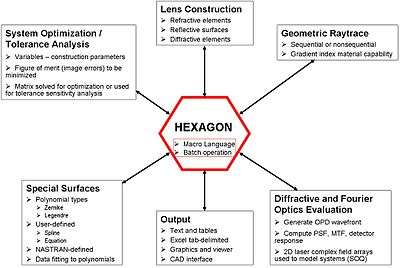Hughes Executable Application for General-Purpose Optical Analysis
The Hughes Executable Application for General-Purpose Optical Analysis (HEXAGON) is an in-house optical engineering software program developed by Hughes Aircraft Company to allow them to design and analyze a wide variety of optical lens systems.
History
In the 1970s Hughes Aircraft Company acquired the software code ACCOS-V and extensively upgraded it while maintaining the command structure: entry consists of a command word (case insensitive) up to six letters long, followed by an optional qualifier word up to eight letters long, then either a text field or a numeric field containing up to five numbers. The new code was named HEXAGON and many optical designers used interactive terminals to run the program on an IBM 4341 mainframe computer. In the 1980s the program expanded its capabilities in optimization, tolerance analysis, and physical optics; this later capability is a subset of HEXAGON named SOQ, for System Optical Quality, that models coherent laser systems using a two-dimensional complex field array. In 1985 Hughes was sold to General Motors and renamed GMH; in 1997 GMH was acquired by Raytheon Company. Currently Raytheon has exclusive use of the proprietary software code. The acronym HEXAGON is now said to stand for "Handy EXpert Application for General-Purpose Optical Analysis".
Abilities
HEXAGON has an extensive interface capability with other optical design programs (Code V, Zemax, and OSLO); with mechanical CAD programs (Pro/Engineer, AutoCAD, and I-DEAS); and the structural CAD program Nastran. Data can be easily exported to and imported from MATLAB and Excel. Graphical output can be vector graphics, viewed with a built-in viewer or output to WMF format for inclusion in Word or PowerPoint, or bit-map graphics (BMP) image files.
Input is entirely command driven, allowing unattended batch operation; a built-in Macro programming language allows the construction of a simple new "command" that can execute other commands in a complex manner. Users store their own previously written macros in a macro libraries (a single disk file), and there is an extensive "permanent" macro library available for all users.
The diagram below shows some of the features of the HEXAGON software:

References
See also
- Optical engineering
- Ray tracing (physics)
- Code V
- Optics Software for Layout and Optimization (OSLO)
- Zemax